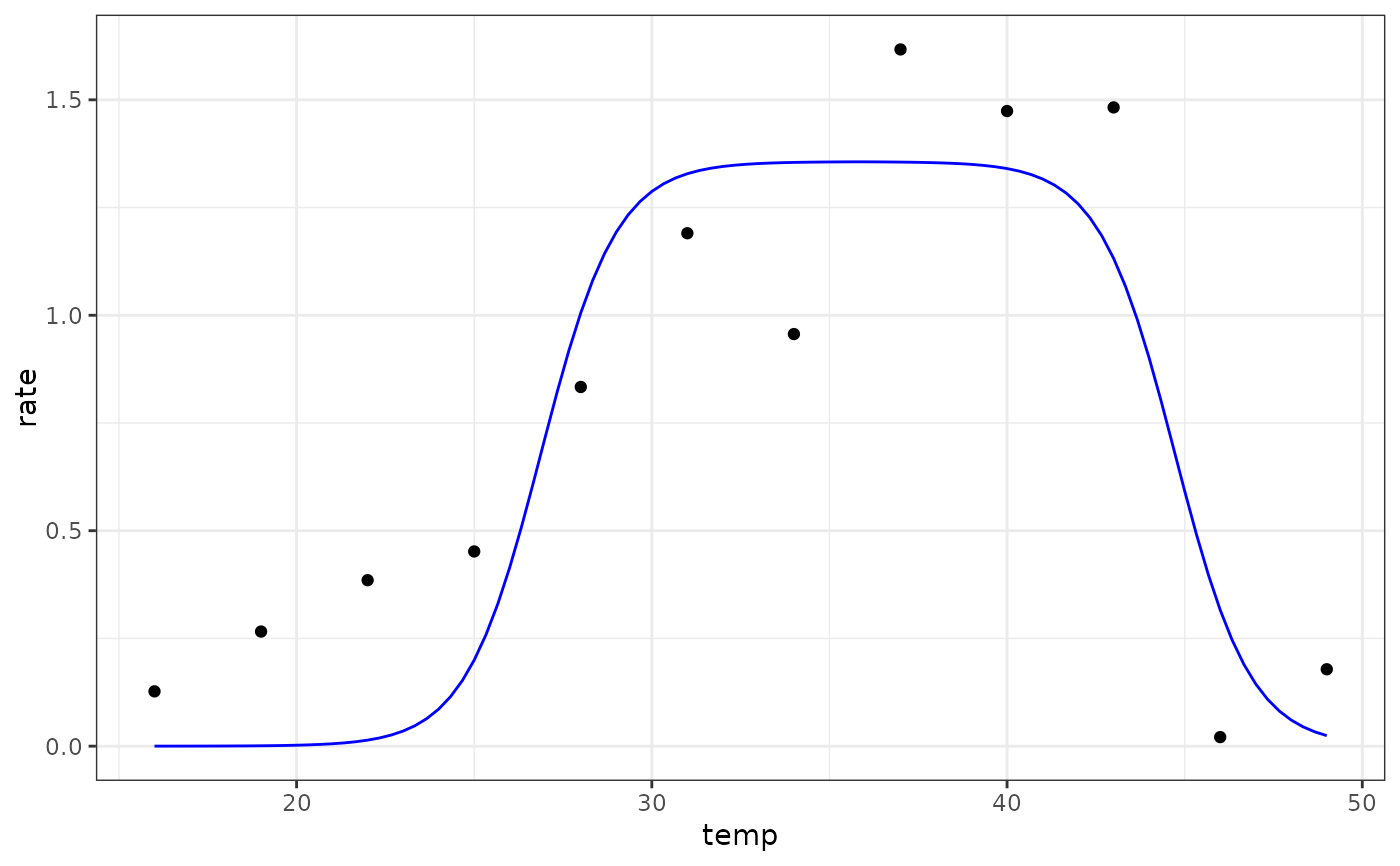Stinner model for fitting thermal performance curves
Value
a numeric vector of rate values based on the temperatures and parameter values provided to the function
Details
Equation: $$\textrm{if} \quad temp <= t_{opt}: rate = rmax \cdot \frac{1 + exp^{a + b \cdot t_{opt}}}{(1 + exp^{a + b \cdot temp}}$$ $$\textrm{if} \quad temp <= t_{opt}: rate = rmax \cdot \frac{1 + exp^{a + b \cdot t_{opt}}}{(1 + exp^{a + b \cdot (2 \cdot t_{opt} - temp)}}$$
Start values in get_start_vals are derived from the data or sensible values from the literature.
Limits in get_lower_lims and get_upper_lims are derived from the data or based extreme values that are unlikely to occur in ecological settings.
References
Stinner, R. E., Gutierrez, A. P., & Butler Jr, G. D. (1974). An algorithm for temperature-dependent growth rate simulation12. The Canadian Entomologist, 106(5), 519-524.
Examples
# load in ggplot
library(ggplot2)
# subset for the first TPC curve
data('chlorella_tpc')
d <- subset(chlorella_tpc, curve_id == 1)
# get start values and fit model
start_vals <- get_start_vals(d$temp, d$rate, model_name = 'stinner_1974')
# fit model
mod <- nls.multstart::nls_multstart(rate~stinner_1974(temp = temp, rmax, topt, a, b),
data = d,
iter = c(5,5,5,5),
start_lower = start_vals - 10,
start_upper = start_vals + 10,
lower = get_lower_lims(d$temp, d$rate, model_name = 'stinner_1974'),
upper = get_upper_lims(d$temp, d$rate, model_name = 'stinner_1974'),
supp_errors = 'Y',
convergence_count = FALSE)
# look at model fit
summary(mod)
#>
#> Formula: rate ~ stinner_1974(temp = temp, rmax, topt, a, b)
#>
#> Parameters:
#> Estimate Std. Error t value Pr(>|t|)
#> rmax 1.3561 0.1736 7.813 5.18e-05 ***
#> topt 35.8015 0.7858 45.558 5.95e-11 ***
#> a 25.1686 14.7144 1.710 0.126
#> b -0.9365 0.5479 -1.709 0.126
#> ---
#> Signif. codes: 0 ‘***’ 0.001 ‘**’ 0.01 ‘*’ 0.05 ‘.’ 0.1 ‘ ’ 1
#>
#> Residual standard error: 0.3192 on 8 degrees of freedom
#>
#> Number of iterations till stop: 98
#> Achieved convergence tolerance: 1.49e-08
#> Reason stopped: Number of calls to `fcn' has reached or exceeded `maxfev' == 500.
#>
# get predictions
preds <- data.frame(temp = seq(min(d$temp), max(d$temp), length.out = 100))
preds <- broom::augment(mod, newdata = preds)
# plot
ggplot(preds) +
geom_point(aes(temp, rate), d) +
geom_line(aes(temp, .fitted), col = 'blue') +
theme_bw()

